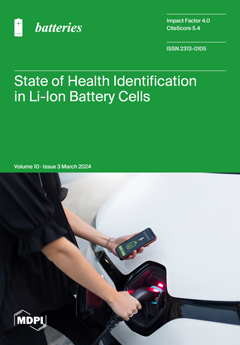Layered ternary materials with high nickel content are regarded as the most promising cathode materials for high-energy-density lithium-ion batteries, owing to their advantages of high capacity, low cost, and relatively good safety. However, as the nickel content increases in ternary layered materials, their
[...] Read more.
Layered ternary materials with high nickel content are regarded as the most promising cathode materials for high-energy-density lithium-ion batteries, owing to their advantages of high capacity, low cost, and relatively good safety. However, as the nickel content increases in ternary layered materials, their thermal stability noticeably decreases. It is of paramount importance to explore the characteristics of thermal runaway for lithium-ion batteries. In this study, two high-nickel LiNi
0.9Co
0.05Mn
0.05O
2 batteries were laterally heated to thermal runaway in a sealed chamber filled with nitrogen to investigate the thermal characteristics and gas compositions. The temperature of the battery tabs was measured, revealing that both batteries were in a critical state of thermal runaway near 120 degrees Celsius. A quantitative analysis method was employed during the eruption process, dividing it into three stages: ultra-fast, fast, and slow; the corresponding durations for the two batteries were 3, 2, 27 s and 3, 3, 26 s. By comparing the changes in chamber pressure, it was observed that both batteries exhibited a similar continuous venting duration of 32 s. However, the pressure fluctuation ranges of the two samples were 99.5 and 68.2 kPa·m·s
−1. Compared to the other sample, the 211 Ah sample exhibited larger chamber pressure fluctuations and reached higher peak pressures, indicating a higher risk of explosion. In the experimental phenomenon captured by a high-speed camera, it took only 1 s for the sample to transition from the opening of the safety valve to filling the experimental chamber with smoke. The battery with higher energy density exhibited more intense eruption during thermal runaway, resulting in more severe mass loss. The mass loss of the two samples is 73% and 64.87%. The electrolyte also reacted more completely, resulting in a reduced number of measured exhaust components. The main components of gaseous ejections are CO, CO
2, H
2, C
2H
4, and CH
4. For the 211 Ah battery, the vented gases were mainly composed of CO (41.3%), CO
2 (24.8%), H
2 (21%), C
2H
4 (7.4%) and CH
4 (3.9%), while those for the other 256 Ah battery were mainly CO (30.6%), CO
2 (28.5%), H
2 (21.7%), C
2H
4 (12.4%) and CH
4 (5.8%). Comparatively, the higher-capacity battery produced more gases. The gas volumes, converted to standard conditions (0 °C, 101 kPa) and normalized, resulted in 1.985 L/Ah and 2.182 L/Ah, respectively. The results provide valuable guidance for the protection of large-capacity, high-energy-density battery systems. The quantitative analysis of the eruption process has provided assistance to fire alarm systems and firefighting strategies.
Full article





